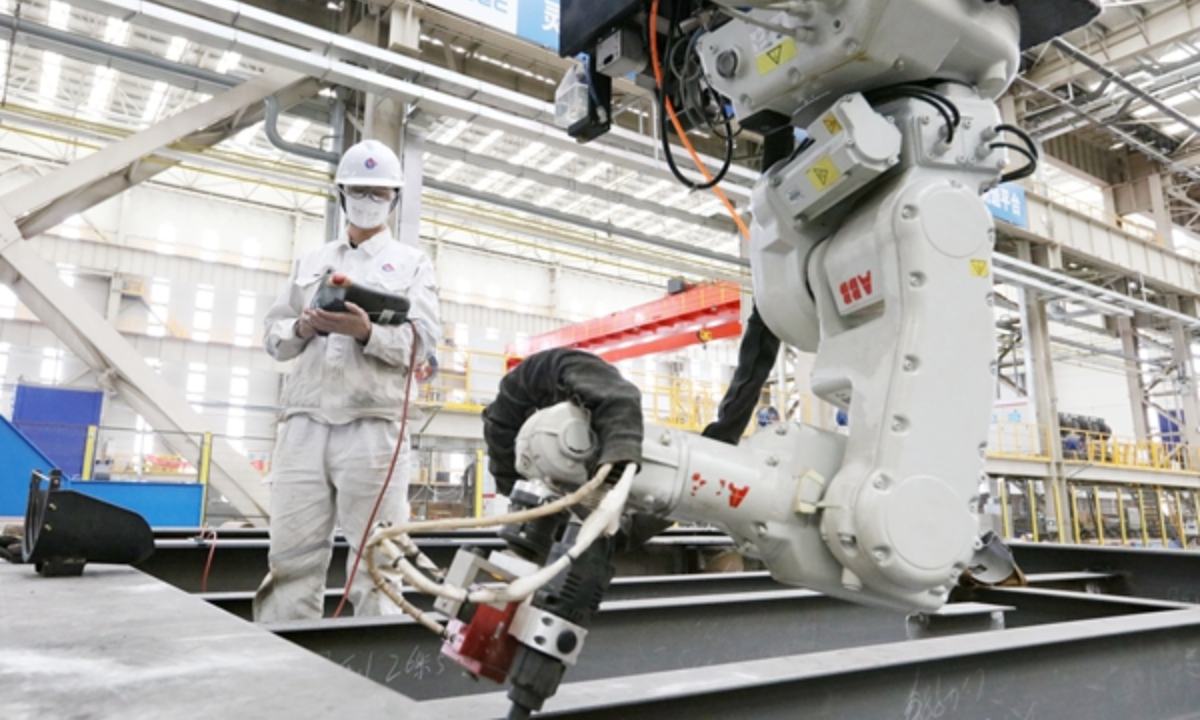China’s first intelligent factory for producing offshore gas and oil extraction equipment started its operations on June 26, marking a huge step forward in the manufacturing digitization of the marine energy sector.
The facility comprises three intelligent production centers, seven auxiliary workshops, and eight assembly stations on an area of approximately 575,000 square meters, reported Global Times, citing China National Offshore Oil Corp (CNOOC).
The facility, located in Tianjin Municipality in North China, will boost production efficiency by more than 20%, thanks to over 400 sets of intelligent machines that can cover all stages of production.
The factory has an annual output capacity of 84,000 tons and a dock capable of harboring large offshore engineering ships like floating production storage and offloading (FPSO) and liquefied natural gas (LNG) carriers.

Intelligent equipment reduces the need for a workforce and eliminates hazards while producing metal parts. The report said that the plant accomplishes 90% automatic steel cutting and 70% automatic welding.
The Tianjin facility uses cutting-edge technology, including 5G, big industrial data, and artificial intelligence, according to Yu Yi, chairman of the board of Offshore Oil Engineering Co under CNOOC.
The intelligent factory incorporates innovative systems, including smart manufacturing, smart warehouse management, intelligent security, monitoring, and logistics.
“The digital, intelligent operation management mode realized in the Tianjin factory can be promoted and used in the entire marine oil and gas extraction equipment manufacturing industry,” said Yu.
The factory, designed by a research team of over 200 engineers in collaboration with China’s leading universities and organizations, used approximately ten cutting-edge technologies, according to CNOOC.
China’s Quest For Energy Security
Chinese President Xi Jinping has prioritized strengthening domestic energy security in recent years. He previously stated that his administration would lead an “energy revolution” to reduce energy use, increase energy supply, and enhance energy efficiency.

While the statement was missing implementation details, the three reform initiatives mentioned in his speech serve as the foundation for China’s future policy orientation and market movements.
The intelligent factory could be one of the cornerstones to support these goals. Additionally, China’s aspirations for oil and gas have frequently led to standoffs with its neighbors. And the South China Sea continues to be a significant point of these standoffs.
According to US Energy Information Agency estimates, the South China Sea has probable reserves of 11 billion barrels of oil and around 190 trillion cubic feet of natural gas.
In Jan 2021, Chinese authorities revealed plans to deploy their country’s first semi-submersible oil rig in a deep-water field in the disputed South China Sea. The move was reportedly aimed at increasing its political influence and demonstrating to rivals how far it is prepared to go for energy security.
Beijing asserts ownership of about 90% of the South China Sea and supports its claim with historical data. It has developed islets in the sea that extend from its southern beaches to the island of Borneo, using its technological and military prowess over the other claimants.
Other claimants Brunei, Malaysia, the Philippines, and Vietnam, conduct oil and gas exploration in the same 3.5 million-square-kilometer sea.
China, a net oil importer since 1993, is trying to alleviate its “fear of strategic vulnerability” by importing fuel from other countries, developing natural gas, and increasing its Middle Eastern refinery capacity.
In the past, Chinese efforts to explore oil and gas in the South China Sea have heightened tensions, most notably in 2014 when the state-run China National Offshore Oil Corp (CNOOC) set up a Deep-water drilling rig in Vietnam-claimed waters.
Beijing, though, continues to pursue its goals. In April 2021, China drilled deep into the South China Sea to extract sediment cores from the ocean floor. Drilling with China’s domestic “Sea Bull II” system allowed Chinese researchers aboard a marine research vessel to extract a sediment core measuring 231 meters (253 yards) in length from a depth of 2,060 meters (6,760 feet).
China is driving these efforts forward with its technological prowess, but it still has major geopolitical obstacles to overcome.
Politically and legally, cooperation on contested oil and gas resources is more challenging than in the case of fisheries or environmental management. The South China Sea is a semi-enclosed sea, and the United Nations Convention on the Law of the Sea (UNCLOS) does not contain any provisions requiring states to work together to manage their oil and gas resources.
UNCLOS articles 74 and 83 specify that states should exhibit mutual restraint and create “provisional arrangements of a practical nature” to resolve their disputes without a permanent demarcation of maritime boundaries, which provides a limited basis for compromise.
Nonetheless, China appears to be making tremendous progress toward securing its energy security. With the launching of the latest factory, it will likely be able to do so even more swiftly.
- Contact the author at ashishmichel@gmail.com
- Follow EurAsian Times on Google News




